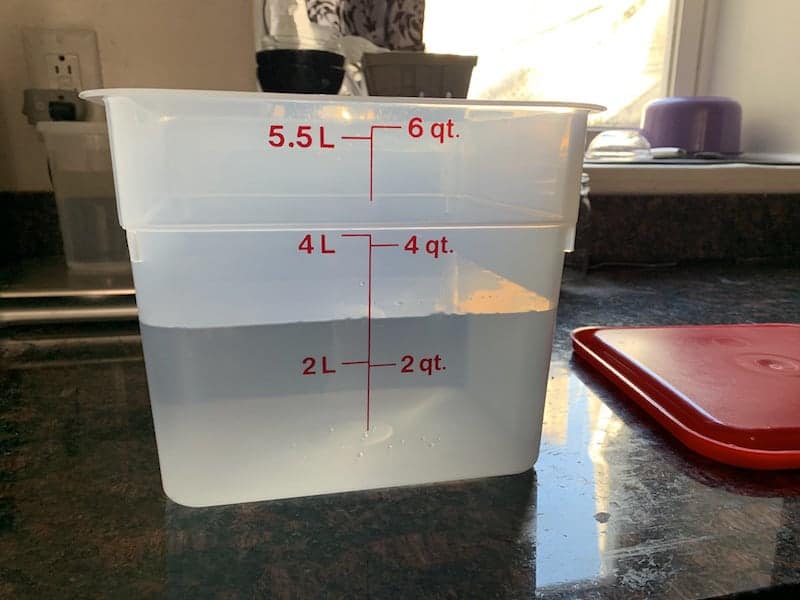Joule Sous Vide Water Level: Everything You Need to Know
Have you noticed that your Joule doesn’t have max or min lines drawn on the side of it? Most sous vide cookers have this feature, which can make filling your sous vide container with water much easier.
If you’re wondering what the Joule Sous Vide water level should be when using the device, you’re in the right place. The minimum water depth of the Joule is 1.5 in (38 mm), and the maximum is 8 in (203 mm). Also, the Joule can efficiently heat up between 2.5 and 10 gallons of water, depending on if you have a lid for your sous vide container and how well insulated it is. Keep reading to learn more.

Joule Sous Vide Minimum Water Depth and Maximum Water Depth
In order for the Joule to operate, the water level in the sous vide container has to fall between the minimum water depth and the maximum water depth.
Unfortunately, unlike most other sous vide machines, the Joule doesn’t have minimum and maximum lines drawn onto the side of the device. According to the guide that comes with the Joule, you have to draw an imaginary line. This makes it difficult to remember where exactly you can fill your water bath too each time you use the Joule.
The exact minimum water depth of the Joule is 1.5 in (38 mm), and the exact maximum water depth is 8 in (203 mm). These numbers are based on if your Joule is sitting at the bottom of the pot or container.
You can raise the maximum water level further by clipping the joule to the side of the container, so it sits higher up. If you do this, the maximum water level can vary, depending on the height of the container you’re using.
Joule Sous Vide Max Water Capacity
Next let’s talk about how much water the Joule can heat up.
The Joule Sous Vide max water capacity can vary depending on your sous vide setup. Essentially, if you have an insulated container with a lid, your Joule can heat up more water. As you lose insulation and covering for the container, the amount of water the Joule can heat decreases.
Check out the table below. These numbers are based on Chefsteps’ (now Breville’s) guidance.
| Well-insulated container with a lid | 10 gallons (40 liters) |
| Container with a lid | 5 gallons (20 liters) |
| Just an uncovered container | 2.5 gallons (10 liters) |
The reason these numbers vary based on your sous vide setup is because having insulation and a lid prevent water from evaporating out of the container.
Without them, water can leave the container faster through evaporation, giving your Joule less time to heat up what’s there. So if you don’t have a well-insulated container or lid, you should use a smaller volume of water to make sure your Joule can heat it all efficiently.
Many sous vide containers come with lids customized with holes to fit your Joule. Or, you can cut a hole out of a lid yourself or even use plastic wrap or ping pong balls – click here to learn more.
When it comes to good insulation, in general, metal pots are poorly insulated. This is one of the reasons why polycarbonate containers (like the ones from Cambro or Rubbermaid) are very popular for sous vide cooking. For added insulation, insulation sleeves are excellent. They’re designed for polycarbonate containers (not pots).
If you usually cook larger quantities of food, being able to heat up larger volumes of water is probably important to you. In this case, I recommend having a good sous vide container with a lid and insulation sleeve. This container by EVERIE that’s available on Amazon is my number one favorite sous vide container that comes with a lid and sleeve.
Dealing with the Joule Water Level Too Low Error
It’s not uncommon in sous vide cooking for the water level to drop too low. When this happens, Joule shows a “low water” error message in the app and automatically shuts off.
This first thing you should do is to make sure there’s enough water in your sous vide container. Go back to the last section to see where exactly your water level should be.
Next you can try restarting your Joule. To do this, just unplug it, wait for 30 seconds, then plug it back in.
Another thing you can do is check the propeller:
- Make sure your Joule is unplugged and has completely cooled since using it.
- Carefully unscrew the foot at the bottom of the device.
- Check the propeller. Make sure there’s nothing blocking it. Check to make sure it’s not damaged or broken and is aligned properly. Lastly, make sure it can spin properly and stays attached while doing so.
Finally, if you’re still seeing the low water error message on your Joule after trying the above, try cleaning it. I’ve outlined the steps for cleaning the Joule here – check it out.
If none of the above work, then your last option is to contact Breville for assistance.
In Summary
Not having max and min lines on the Joule can be frustrating when you’re trying to set up your water bath.
Hopefully this guide helped you understand how much water the Joule can heat up and where you should be filling the water bath to to get the best results out of your Joule.







